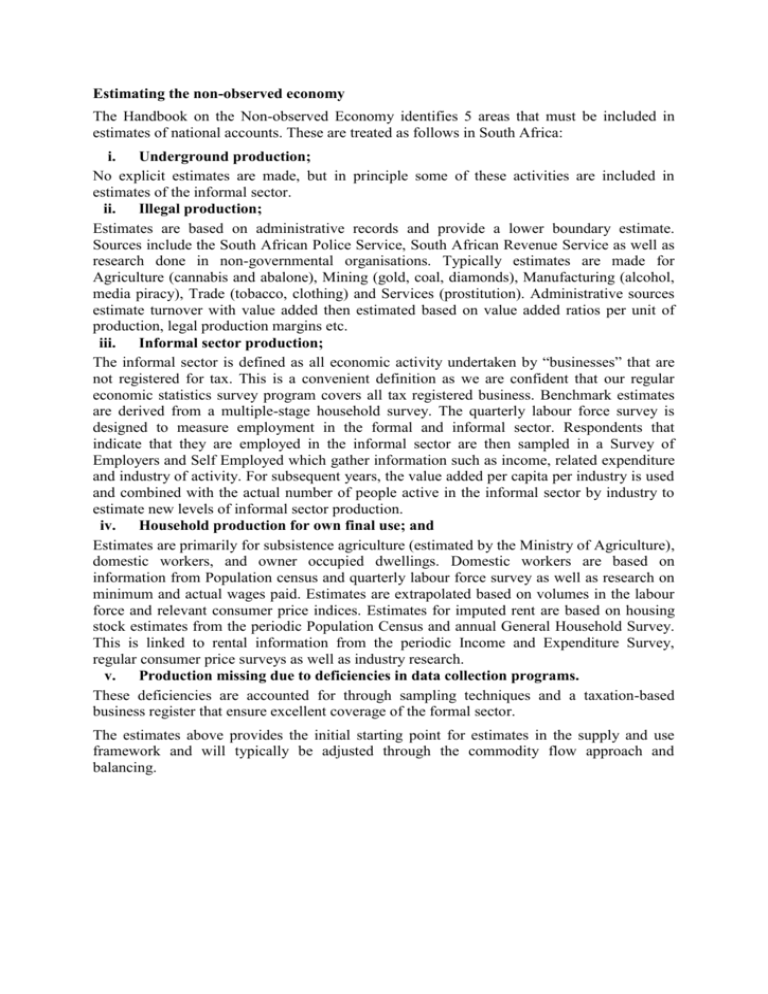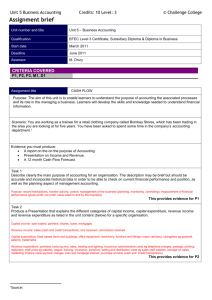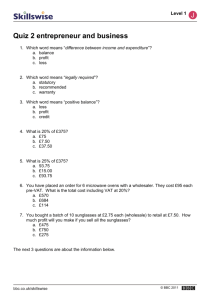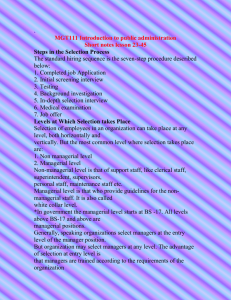South Africa - African Centre for Statistics
advertisement

Estimating the non-observed economy The Handbook on the Non-observed Economy identifies 5 areas that must be included in estimates of national accounts. These are treated as follows in South Africa: i. Underground production; No explicit estimates are made, but in principle some of these activities are included in estimates of the informal sector. ii. Illegal production; Estimates are based on administrative records and provide a lower boundary estimate. Sources include the South African Police Service, South African Revenue Service as well as research done in non-governmental organisations. Typically estimates are made for Agriculture (cannabis and abalone), Mining (gold, coal, diamonds), Manufacturing (alcohol, media piracy), Trade (tobacco, clothing) and Services (prostitution). Administrative sources estimate turnover with value added then estimated based on value added ratios per unit of production, legal production margins etc. iii. Informal sector production; The informal sector is defined as all economic activity undertaken by “businesses” that are not registered for tax. This is a convenient definition as we are confident that our regular economic statistics survey program covers all tax registered business. Benchmark estimates are derived from a multiple-stage household survey. The quarterly labour force survey is designed to measure employment in the formal and informal sector. Respondents that indicate that they are employed in the informal sector are then sampled in a Survey of Employers and Self Employed which gather information such as income, related expenditure and industry of activity. For subsequent years, the value added per capita per industry is used and combined with the actual number of people active in the informal sector by industry to estimate new levels of informal sector production. iv. Household production for own final use; and Estimates are primarily for subsistence agriculture (estimated by the Ministry of Agriculture), domestic workers, and owner occupied dwellings. Domestic workers are based on information from Population census and quarterly labour force survey as well as research on minimum and actual wages paid. Estimates are extrapolated based on volumes in the labour force and relevant consumer price indices. Estimates for imputed rent are based on housing stock estimates from the periodic Population Census and annual General Household Survey. This is linked to rental information from the periodic Income and Expenditure Survey, regular consumer price surveys as well as industry research. v. Production missing due to deficiencies in data collection programs. These deficiencies are accounted for through sampling techniques and a taxation-based business register that ensure excellent coverage of the formal sector. The estimates above provides the initial starting point for estimates in the supply and use framework and will typically be adjusted through the commodity flow approach and balancing. Treatment of taxes on products In South Africa, the supply and use table includes 6 types of taxes on products. The basic methodology is to determine a structure (spread) of these taxes across the relevant products according to their CPC classification. These distributions are then applied to control totals to ensure consistency with information in Government Finance Statistics. In the case of transfer duties (other services), provincial taxes on goods and services (other services), fuel levies (petroleum products), excise duties (fuel, alcohol and tobacco) and customs duties (various products across the spectrum) the taxes can be linked directly to specific commodity groups in the use table. The situation is more complex for value added tax. Three areas are estimated independently to derive the VAT-distribution. Economic survey results provide an indication of asset distributions of businesses so that estimates can be made for the payment of VAT on real estate services. Secondly detailed industry expenditure surveys are used to determine product groups from which VAT expenditure will not be claimed as opposed to expenditure on which VAT is payable. Thirdly a household income and expenditure survey is used to determine private consumption expenditure on commodity groups on which VAT is payable as opposed to be VAT exempt or that are zero rated. In all three cases expert opinion is used to make adjustments to these VAT-payable distributions before they are combined into a single distribution key for the economy. The VAT distribution key remains in place until the next benchmark round, whereas the other types of taxes on products can be easily linked and updated on an annual basis.
![Facilities Claim Form [docx / 210KB]](http://s3.studylib.net/store/data/009702131_1-a76a963067a4586a4f8f1bca351ecaf7-300x300.png)










